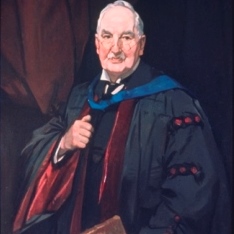
Biography
Byrom Bramwell was born on 18 December 1847 in North Shields, where his father worked as a general practitioner. He was educated at Cheltenham College where he showed significant sporting prowess. In 1865 he went to medical school at Edinburgh which he himself described 57 years later in a fascinating talk to the Edinburgh Royal Medical Society. Bramwell tells of being taught by many Edinburgh luminarie including John Goodsir, John Hughes Bennett, James Syme and James Young Simpson, whom he particularly praised. Bramwell’s interest in sport continued at university and he captained the University cricket team.
In 1869 Bramwell became house surgeon to James Spence, the Professor of Surgery. A career in Edinburgh beckoned but his father was ill and he returned to North Shields to work in the family medical practice. His career in the North East flourished, culminating in his appointment in 1874 as physician and pathologist at Newcastle Royal Infirmary. In 1879 Bramwell took what must have been a career risk and moved to Edinburgh. He became a Fellow of the Royal College of Physicians of Edinburgh in 1880 and, after a slow start, his risk paid off as both his private practice and his academic career flourished. He became a lecturer in the Edinburgh extramural School of Medicine where he taught women students and in 1897 he was made a physician at the Royal Infirmary.
In 1900 he was one of the unsuccessful contenders for the Chair of Medicine at Edinburgh (Osler was also a candidate but withdrew). This must have been a big a disappointment for the enthusiastic and industrious teacher and author. Evidence of his industry is contained in nine volumes of clinical reports, ten books, an Atlas of Clinical Medicine (three volumes, 1892–6), and more than 160 papers. Both Intracranial Tumours (1888), which Harvey Cushing was still praising in 1931, and Diseases of the Spinal Cord (1881) were international successes. In Anaemia and some Diseases of the Blood-Forming Organs and Ductless Glands (1899) Bramwell surveyed another large area of medicine by reviewing 14,777 cases.
Byrom Bramwell was President of the Royal College of Physicians of Edinburgh from 1910 to 1912. During his presidency one of the first steps towards the formation of the United Kingdom's National Health Service, the 1911 National Insurance Act, was being debated by the College. He was much honoured, including a knighthood in 1924, and he was the first non-member clinician to be elected a Fellow of the Royal College of Physicians of London. Byrom Bramwell died in Edinburgh, close to the College, in his house at 10 Heriot Row, on 27 April 1931. Two of his sons were doctors and one (Edwin) was also a president of the Edinburgh College.
Notable Achievements
In 1882, Bramwell was appointed Pathologist at Edinburgh Royal Infirmary.
Bramwell became a Fellow of the Royal Society of Edinburgh in 1886.
In 1887, Bramwell was appointed Physician at the Edinburgh Royal Infirmary.
From 1910 to 1912 Bramwell was president of the Royal College of Physicians of Edinburgh.
Bramwell received the honorary degree of LLD from Edinburgh, Birmingham, St Andrews, and of DCL from Durham.
In 1922, Bramwell was knighted.
Received the honorary degree of LLD from the universities of Edinburgh, Birmingham, St Andrews, and of DCL from Durham.
Key Publications
Bramwell was a prolific author who published extensively on the practice, teaching and general aspects of medicine. He produced nine volumes of clinical reports, ten books, and more than 160 papers.
- Diseases of the Spinal Cord (1881)
- Intracranial Tumours (1888)
- Atlas of Clinical Medicine (3 vols., 1892–6)
- Anaemia and some Diseases of the Blood-Forming Organs and Ductless Glands (1899)
- Lectures on Aphasia (1897)



